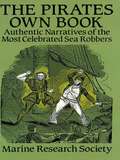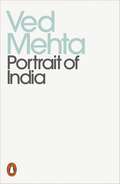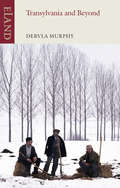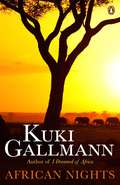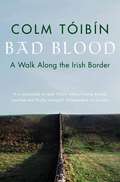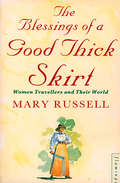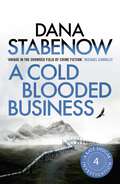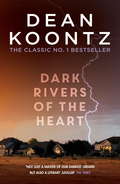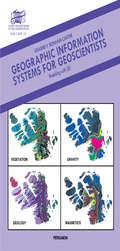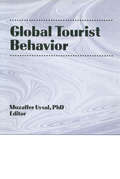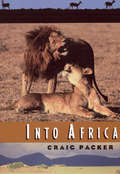- Table View
- List View
The Mammoth Book of Travel in Dangerous Places: Antarctic (Mammoth Books)
by John KeayFarthest South - Ernest Henry ShackletonBorn in Ireland, Shackleton joined the merchant navy before being recruited for Captain Scott's 1901 expedition to Antarctica. He was with Scott on his first attempt to reach the South Pole and, though badly shaken by the experience, realized that success was now feasible. In 1907, with a devoted team but little official support, he launched his own expedition. A scientific programme gave it respectability but Shackleton was essentially an adventurer, beguiled alike by the challenge of the unknown and the reward of celebrity. His goal was the Pole, 90 degrees south, and by Christmas 1908 his four-man team were already at 85 degrees.The Pole at Last - Roald AmundsenAmundsen's 1903-6 voyage through North West Passage had heralded a new era in exploration. The route by then was tolerably well known and its environs explored. His vessel was a diminutive fishing smack, his crew a group of Norwegian friends, and his object simply to be the first to have sailed through. He did it because it had not been done and "because it was there". The same applied to his 1911 conquest of the South Pole. Shackleton had shown the way and Amundsen drew the right conclusions. The Pole was not a scientist's playground nor a mystic's dreamland; it was simply a physical challenge. Instead of officers, gentlemen and scientists, he took men who could ski and dogs that could pull; if need be, the former could eat the latter. The only real anxiety was whether they would forestall Scott.In Extremis - Robert Falcon ScottScott was chosen to lead the 1900-4 British National Antarctic Expedition. Its considerable achievements seemed to vindicate the choice of a naval officer more noted for integrity and courage than any polar experience, and, following Shackleton's near success, in 1910 Scott again sailed south intending to combine a busy scientific programme with a successful bid for the South Pole. On 17 January 1912 he and four others duly reached the Pole, indeed they sighted a real pole and it bore a Norwegian flag; Amundsen had got there 34 days ahead of them. Bitterly disappointed, soon overtaken by scurvy and bad weather, and still dragging sledges laden with geological specimens, they trudged back. The tragedy which then unfolded eclipsed even Amundsen's achievement and won them an immortality beyond the dreams of any explorer.
The Mammoth Book of Travel in Dangerous Places: Arabia (Mammoth Books)
by John KeayEscape from Riyadh - William Gifford PalgraveA scholar and a solider, a Jesuit and a Jew, a French spy and a British ambassador- Palgrave was a man of contradictions, all of them highly compromised when in 1862-3, fortified by Pius IX's blessing and Napoleon III's cash, he attempted the first west- east crossing of the Arabian peninsular. To steely nerves and a genius for disguise he owed his eventual success; but not before both were sorely tested when, as a Syrian doctor, he became the first European to enter Riyadh. The desert capital of the fanatical Wahabis, dangerous for an infidel at the best of times, was then doubly so as the sons of the ageing King Feisal intrigued for power.Desert Days - Charles Montagu DoughtyDuring two years (1875-7) wandering in Central Arabia Doughty broke little new ground; dependant on desert charity, his achievement was simply to have survived. Yet his book, Arabia Deserta, was instantly recognized as a classic. Its eccentric prose proves well suited to that minute observation and experience of Bedouin life which was Doughty's main contribution to exploration. T.E. Lawrence called it "a bible of a kind"; both syntax and subject matter have biblical resonances, as in this description of a day's march, or rahla.
The Mammoth Book of Travel in Dangerous Places: Arctic (Mammoth Books)
by John KeayFour Years in the Ice - John RossDisgraced and dishonored for his report of an imaginary mountain range blocking the most likely access to the North West Passage, in 1829 Ross returned to Canada's frozen archipelago to vindicate his reputation. He rounded the north of Baffin Island and entered what he named the Gulf of Boothia. Here the Victory, his eccentric paddle-steamer, became frozen to the ice. Through three tantalizingly brief summers the expedition tried to find a way out and through four long winters then endured the worst of Arctic conditions in a makeshift camp. In July 1832, with the ship long since abandoned, Ross made what must be their last bid to reach open water.Living off Lichen and Leather - John FranklinIn 1845, looking again for the North West Passage, two well-crewed ships under Franklin's command sailed into the Canadian Arctic and were never seen again. There began the most prolonged search ever mounted for an explorer. For Franklin had been lost before and yet had survived. In 1821, returning from an overland reconnaissance of the Arctic coast north of Great Slave Lake, he and Dr. John Richardson, with two Lieutenants and about a dozen voyageurs (mostly French), had run out of food and then been overtaken by the Arctic weather. Franklin's narrative of what is probably the grisliest journey on record omits unpalatable details, like the cannibalism of one of his men, the murder of Lieut. Hood, and Richardson's summary shooting of the murderer; but it well conveys the debility of men forced to survive on leather and lichen (triple de roche) plus that sense of demoralization and disintegration that heralds the demise of an expedition.Adrift on an Arctic Ice Floe - Fridtjof Nansen Norwegian patriot, natural scientist, and Nobel laureate, Nansen caught the world's imagination when he almost reached the North Pole in 1895. The attempt was made on skis from specially reinforced vessel which, driven into the ice, was carried from Siberia towards Greenland. The idea stemmed from his first expedition, an 1888 crossing of Greenland. Then too he had used skis and then too, unwittingly and nearly disastrously, he had taken to the ice. Arrived off Greenland's inhospitable east coast, he had ordered his five-man party to spare their vessel by crossing the off-shore ice floe in rowing boats. A task which he expected to take a few hours turned into an involuntary voyage down the coast of twelve days.The Pole is Mine - Robert Edwin Peary Born in Pennsylvania and latterly a commander in the US navy, Peary had set his sights on claiming the North Pole from childhood. It was not just an obsession but a religion, his manifest destiny. Regardless of cost, hardship, and other men's sensibilities, he would be Peary of the Pole, and the Pole would be American. Critics might carp over the hundreds of dogs that were sacrificed to his ambition, over the chain of supply depots that would have done credit to a military advance, and over the extravagance of Peary's ambition, but success, in 1909, came only after a catalogue of failures; and even then it would be disputed. Under the circumstances his triumphalism is understandable and, however distasteful, not unknown amongst other Polar travelers.
The Mammoth Book of Travel in Dangerous Places: Australia (Mammoth Books)
by John KeayLandfall at Botany Bay - James CookThe son of a Yorkshire farm labourer, Cook won distinction as a naval hydrographer but was still a controversial choice to command a voyage of scientific observation to the Pacific in 1768. Its results, including the first coastal surveys of New Zealand and eastern Australia, led to a second voyage to the south Pacific and a third to the north Pacific, during which he was killed in a fracas with the Hawaiians. It was a tragic end for one whose humble origins disposed him to respect indigenous peoples. "They are far happier than we Europeans", he noted of Australia's aborigines following a brief encounter at Botany Bay (Sydney), the first European landing on the Pacific coast, in 1770.Escape from the Outback - Charles SturtAfter pioneering journeys to the Darling and Murray rivers, in 1844-5 Sturt headed north for the heart of Australia. Since the continent appeared to have few seaward draining rivers it was assumed that, alike Africa, it must boat an inland lake region; a boat was therefore included amongst the expeditions equipment. But Sturt failed to reach the geographical centre of the continent, and the largest stretch of water found was at Coopers Creek, later to figure so prominently in the endeavours of Burke and Wills. Sturt's painful retreat during the hottest summer on record formed a fitting prelude to the Wills saga.Death at Coopers Creek - William John WillsIn early 1861 Robert O'Hara Burke, William Wills and John King reached Australia's northern coast on the Gulf of Carpentaria, thus completing the first transcontinental crossing. Returning the way they had come, after four months of appalling hardship they staggered into Sturt's Coopers Creek where men and supplies had been left to await their return. They were just eight hours too late; the relief party, despairing of their return, had left that very morning. One of exploration's most poignant moments was followed by one of its most protracted tragedies as the expedition tried to extricate itself, failed, faded, and died. Only King survived; three months later he was discovered living with the aborigines; Will's heartbreaking journal was found lying beside his skeleton.To See the Sea - John McDouall StuartModest, dedicated, immensely tough and thoroughly congenial, Stuart was very much an explorer's explorer. With little support or fuss he began probing north from Adelaide in the late 1850's. In 1860 he was the first to reach the centre of the continent, thus completing the work of Sturt. Although Burke and Wills just beat him in the race to cross the continent, Stuart's 1862 route was much longer and more difficult; and he did actually reach the sea. He was also to return alive.
The Mammoth Book of Travel in Dangerous Places: East and Central Africa (Mammoth Books)
by John KeayAmong the Sudanese - James BruceBruce reached the source of the Blue Nile in 1771, a century before the search for the source of the White Nile became headline news. His descriptions of the cruelties and orgies at Gondar, the Ethiopian capital, were greeted with disbelief; so was his account of the Sudanese rulers, and their queens, at Sennar. He was later shown to be an accurate observer as well as the eighteenth century's most intrepid traveller.Not the Source of the Nile - Richard Francis BurtonIn Burton a brilliant mind and dauntless physique were matched with a restless spirit and a deeply troubled soul to produce the most complex of characters. Contemptuous of other mortals, including Speke, his companion and rival, he found solace only in the extremities of erudition and adventure. A Glimpse of Lake Victoria - John Hanning SpekeIn July 1858, while returning from Lake Tanganyika with Burton, Speke made a solo excursion to the north in search of an even larger lake reported by an Arab informant. Although partially blind and unable to ascertain its extent, he named this lake "Victoria" and boldly declared it the long sought source of the White Nile. The Reservoir of the Nile - Samuel White BakerAmongst professional explorers and big game hunters, none was as successful as Baker. A bluff and plausible figure, wealthy and resourceful, he conducted his explorations on the grand scale, invariably reached his goal and invariably reaped the rewards.Last Days - David LivingstoneLivingstone was nurtured in poverty and religious fervour. He reached southern Africa as a missionary doctor but, more suited to solitary exploration, edged north in a series of pioneering journeys into the interior. Encounters on the Upper Congo - Henry Morton StanleyStanley made his name as an explorer by tracking down Livingstone in 1871. But obscure Welsh origins, plus the adoption of US citizenship and professional journalism, did not endear him to London's geographical establishment. His response was to out-travel all contemporaries, beginning with the first ever coast-to-coast crossing of equatorial Africa. A Novice at Large - Joseph ThomsonBarely twenty and just out of Edinburgh University, Thompson was unexpectedly employed on the Royal Geographical Society's 1878 expedition to the Central African lakes. Unlike Burton he admired Africans; unlike Stanley he would not fight them. His motto - "he who goes slowly, goes safely; he who goes safely, goes far" - was never more seriously tested that when, just six weeks inland from Dar es Salaam, his first expedition lost Keith Johnston, its leader and Thompson's only European companion.
The Mammoth Book of Travel in Dangerous Places: North America (Mammoth Books)
by John KeayFirst Crossing of America - Alexander Mackenzie"Endowed by nature with an acquisitive mind and an enterprising spirit", Mackenzie, a Scot engaged in the Canadian fur trade, resolved, as he out it "to test the practicability of penetrating across the continent of America". In 1789 he followed a river (the Mackenzie) to the sea; but it turned out to be the Arctic Ocean. He tried again in 1793 and duly reached the Pacific at Queen Charlotte Sound in what is now British Columbia. Although this was his first recorded overland crossing of the continent, Mackenzie was not given to trumpeting his achievement. In his narrative it passes without celebration and very nearly without mention.Meeting the Shoshonee - Meriwether LewisAs Thomas Jefferson's personal secretary, Lewis was chosen to lead the US government's 1804-5 expedition to explore (and to establish US interests) from Mississippi to the Pacific. Travelling up the Missouri river to the continental divide in Montana, Lewis left the main party under his colleague William Clark, and scouted ahead. With everything now dependant on securing the goodwill of the formidable Shoshonee, he showed admirable caution; but the issue was eventually decided by a fortuitous reunion between the Indian wife of one of his men and her long-lost brethren.
The Mammoth Book of Travel in Dangerous Places: Siberia and Alaska (Mammoth Books)
by John KeayStranded on Bering Island - Georg Wilhelm StellerAs physician and scientific know-all on Vitus Bering's 1741 voyage, Steller shared its triumphs, including landing the first Europeans in Alaska. He also shared its disasters. Returning across the north Pacific to Russian Kamchatka, the crew was stricken with scurvy and the vessel grounded. Bering and half his men would die; the others barely survived nine months of Arctic exposure. They owed much to the German-born Steller whose response to each crisis was invariably right, although no less irksome for being so.The Walk to Moscow - John Dundas CochraneA naval officer made redundant by the end of the Napoleonic wars, Cochrane offered his services to African exploration. They were declined. He then hit on the idea of making the first solo journey round the world on foot. Heading east, he left Dieppe in 1820 and after some scarcely credible Siberian excursions, reached the Pacific opposite Alaska. There the enterprise foundered when he fell for, and married, a doe-eyed Kamchatkan teenager. In this breathless account of the stages between St. Petersburg and Moscow, the greatest ever "pedestrian traveller" betrays both his extraordinary stamina and his emotional vulnerability.
The Mammoth Book of Travel in Dangerous Places: South America (Mammoth Books)
by John KeayEating Dirt in Venezuela - Alexander von HumboldtGeographer, geologist, naturalist, anthropologist, physician and philosopher, Baron von Humboldt brought to exploration a greater range of enquiry than any contemporary. Also an indomitable traveller, particularly in the Orinoco/Amazon basin (1799-1804), he often invited danger but always in the cause of scientific observation. The interest of his narratives therefore lies primarily in the author's insatiable curiosity and in the erudition that allowed him to generalize from his observations. A classic example is his ever deadpan disquisition on earth-eating. It occurs in the middle of a hair-raising account of descending the Orinoco in Venezuela.Iron Rations in Amazonia - Henry Savage LandorBar Antarctica, Everest and the Empty Quarter, twentieth-century explorers have largely had to contrive their challenges. Landor went one better and contrived the hazards. From Japan, Korea, Central Asia, Tibet, and Africa he returned, always alone, with ever more improbable claims and ever more extravagant tales. The climax came in 1911 with Across Unknown South America, the sort of book that gave exploration a bad name. His route, irrelevant and seldom "unknown", nevertheless demanded superhuman powers of endurance as when the expedition marched without food for fifteen days.The Discovery of Machu Picchu - Hiram BinghamJust when it seemed as if all the "forbidden cities" had been entered and the "lost civilisations" found, there occurred one of the most sensational discoveries in the history of travel. Hiram Bingham, the son of missionary parents in Hawaii, was a lecturer in Latin American history at Yale and Berkeley who devoted his vocations to retracing the routes of Spanish conquest and trade in Columbia and Peru. He was drawn to the high Andes near Cuzco and to the awesome gorges of the Urubamba River by rumours about the existence there of the lost capital and last retreat of the Incas. Machu Picchu was neither; but it richly rewarded his heroic endeavour in reaching it. After excavation by Bingham in 1912 and 1915, it was revealed as the best preserved of the Inca cities and South America's most impressive site.
The Mammoth Book of Travel in Dangerous Places: West Africa (Mammoth Books)
by John KeayAlone in Africa - Mungo ParkPark's 1795-7 odyssey in search of the Niger first awakened the world to the feasibility of a white man penetrating sub-Saharan Africa. But unlike his illustrious successors, this quiet tenant farmer's son from the Scottish Borders travelled alone; relieved of his meager possessions, he was soon wholly dependant on local hospitality. In what he called "a plain unvarnished tale" he related horrific ordeals with admirable detachment - never more tested than on his return journey through Bamako, now the capital of Mali.The Road to Kano - Hugh ClappertonIn one of exploration's unhappier sagas two Scots, Captain Hugh Clapperton and Dr. Walter Oudney, were saddled with the unspeakable Major Dixon Denham on a three year journey to Lake Chad and beyond. Clapperton mapped much of northern Nigeria and emerged with credit. Major Denham also excelled himself, twice absconding, then accusing Oudney of incompetence and Clapperton of buggery. Happily the Major was absent in 1824, after nursing his dying friend, Clapperton became the first European to reach Kano.Down the Niger - Richard LanderAs Clapperton's manservant, Lander attended his dying master on his 1825 expedition to the Niger and was then commissioned, with his brother John, to continue the exploration of the river. The mystery of its lower course was finally solved when in 1831 they sailed down through Nigeria to the delta and the sea. Unassuming Cornishmen, the Landers approached their task with a refreshing confidence in goodwill of Africans. It paid of in a knife-edge encounter at the confluence of the Benoue, although Richard subsequently paid the price with his life.Arrival in Timbuktu - Heinrich BarthBorn in Hamburg, Barth was already an experienced traveler and a methodical scholar when in 1850 he joined a British expedition to investigate Africa's internal slave trade. From Tripoli the expedition crossed the Sahara to Lake Chad. Its leader died but Barth continued on alone, exploring vast tract of the Sahel from northern Cameroon to Mali. Timbuktu, previously visited only by A.G. Laing and René Caillié, provided the climax as Barth, in disguise, approached the forbidden city by boat from the Niger.My Ogowé Fans - Mary KingsleySelf-educated while she nursed her elderly parents, Mary Kingsley had known only middle-class English domesticity until venturing to West Africa in 1892. Her parents had died and, unmarried, she determined to study "fish and fetish" for the British Museum. Her 1894 ascent of Gabon's Ogowé River (from Travels in West Africa, 1897) established her a genuine pioneer and an inimitable narrator. She died six years later while nursing prisoners during the Boer War.
The Pirates Own Book: Authentic Narratives of the Most Celebrated Sea Robbers (Dover Maritime Series)
by Marine Research SocietyIn these delightfully melodramatic accounts, originally published in an extremely rare 1837 volume, you'll find true stories of the diabolical desperadoes who plundered ships on the high seas and murdered their passengers and crews. The stories — based on contemporary newspaper accounts, trial proceedings, and Admiralty records — describe in lurid detail the life, atrocities, and bloody death of the infamous Black Beard as well as the cold-blooded exploits of Jean Lafitte, Robert Kidd, Edward Low, Thomas White, Anne Bonney, Mary Read, and scores of other maritime marauders.The first edition of The Pirates Own Book was published in Boston, Massachusetts, in 1837, and during the next 25 years it was followed by at least eight other editions. Today it is a rarity among collectors. Now available once again in this inexpensive edition, it will thrill lovers of drama on the high seas or any reader interested in the true-life adventures of the ruthless men and women who sailed under the black flag so long ago.
Portrait of India
by Ved MehtaReturning to 1960s' India after decades beyond its borders, Ved Mehta explores his native country with two sets of eyes: those of the man educated in the West, and those of the child raised under the Raj. Travelling from the Himalayas in the east to Kerala in the west, Ved Mehta's observations and insights into India and some of its most interesting figures - including Indira Gandhi, Jaya Prakash Narayan and Satyajit Ray - create one of the twentieth century's most thought-provoking travel memoirs.
Transylvania and Beyond
by Dervla MurphyShortly after the execution of Nicolae Ceaușescu, Dervla Murphy travelled to Romania and found a nation both exhilarated and bewildered by revolution. Eager to explore a country that had hitherto been inaccessible to outsiders, Murphy describes in lucid detail a journey on two planes: cycling and ambling through the rural Carpathians, and exploring the mind-set of a post-Communist society in the grips of an identity crisis. She is treated to tremendous hospitality wherever she goes, and in urban blocs, small towns and traditional villages she gets to know the ordinary Romanians – the teachers, farmers, professors, factory-workers, writers, engineers, vets, army officers, shepherds, students and doctors. Transylvania and Beyond is the story of their hopes, fears and prejudices, a passionate insight into what Murphy calls ‘one of Europe’s least European countries.’
The Ukimwi Road: from Kenya to Zimbabwe (Isis Large Print Ser.)
by Dervla MurphyAllowing herself several months to unwind, Dervla Murphy, at sixty, set off on a three-thousand-mile bike ride from Kenya to Zimbabwe via Uganda, Tanzania, Malawi and Zambia. She soon realized that, for travellers in search of tranquillity, Africa is best avoided. Beguiled by the loquacious people she met, she was nevertheless preoccupied by their immense hardships: the devastating effects of AIDS (or ukimwi as it’s called in Swahili); drought and economic collapse; scepticism about Western aid schemes; and corruption and incompetence. During her journey, Murphy was sustained by her extraordinary thirst for adventure. Despite being beaten by paramilitaries, and having to endure starvation and a bout of malaria, her deeply personal, compassionate and often humorous description of East Africa and its peoples is high-spirited and hugely compelling.
African Nights: True Stories From The Author Of I Dreamed Of Africa (Ulverscroft Large Print Ser.)
by Kuki GallmannStunningly repackaged, Kuki Gallmann's African Nights vividly portrays the harsh and beautiful landscapes of Africa.Africa evokes a deep sense of mystery. It is a place that retains what most of the world has lost: space, roots, traditions, awesome beauty, true wilderness, rare animals, and extraordinary people. In this wonderful and haunting collection of stories, Kuki Gallmann writes of her life in Africa, where every day brings challenge and adventure. African Nights is a treasury of memories, in which fascinating people and places are brought to life. It he healing powers Africa can have on those who embrace the land as a place of mystery, superstition, danger, and beauty.'Captures perfectly the magic of Kenya, creating an almost overwhelming picture of beauty and drama, pain and joy, death and resurrection . . . Her discovery of African culture, with its mystery and danger, is recounted in spare, lyrical prose' New York Times'Powerful, poetic, unbearably moving: I wept' Clare Francis (on I Dreamed of Africa)Kuki Gallmann was born near Venice and moved to Kenya in 1972 with her husband and young son. Following their deaths, she set up the Gallmann Memorial Foundation to promote new ways of combining development and conservation, and to provide sponsorship for the education of Kenyans. Her first book, I Dreamed of Africa, was published in 1991 to international acclaim and it became a world-wide bestseller. She lives in Kenya with her daughter and her dogs.
Bad Blood
by Colm TóibínIn the summer after the Anglo-Irish Agreement, when tension was high in Northern Ireland, Colm Tóibín walked along the border from Derry to Newry. Bad Blood is a stark and evocative account of this journey through fear and hatred, and a report on ordinary life and the legacy of history in a bleak and desolate landscape.Tóibín describes the rituals – the marches, the funerals, the demonstrations – observed by both communities along the border, and listens to the stories which haunt both sides. With sympathy and insight Bad Blood captures the intimacy of life along one of the most contested strips of land in Western Europe.
The Blessings of a Good Thick Skirt: Women Travellers And Their World
by Mary RussellFor the first time in ebook format.
A Cold Blooded Business (A Kate Shugak Investigation #4)
by Dana StabenowThe Edgar Award-winning, New York Times-bestselling series by Dana Stabenow set in Alaska. In A Cold Blooded Business, Kate Shugak investigates a drugs ring at an oil company – at great personal risk...Prudhoe Bay, Alaska: population 2,000. Approximate number of families: zero. And America's largest oilfield...In three months, the Prudhoe Bay oil operation has logged half a dozen drug overdoses, and one death: a man found floating face down in the company pool wearing full flight gear.Now the Alaskan Royal Petroleum Company is in need of a discreet investigator on the inside. Someone who can navigate a flat-bed truck against Arctic wind at forty degrees below freezing and find out who is running a narcotic ring from within the company.Sounds like a job for Kate Shugak...Reviewers on Dana Stabenow's Kate Shugak series:'An antidote to sugary female sleuths: Kate Shugak, the Aleut private investigator.' New York Times 'Crime fiction doesn't get much better than this.' Booklist 'If you are looking for something unique in the field of crime fiction, Kate Shugak is the answer.' Michael Connelly 'An outstanding series.' Washington Post 'One of the strongest voices in crime fiction.' Seattle Times
Dark Rivers of the Heart: A story of unrelenting suspense that delivers a high-charged kick
by Dean KoontzWill he be able to solve the mystery that has him running from the law? If you delight in the suspense of Stephen King and The Stranger by Harlan Coben chilled you to the bone (in the best possible way), you'll love Dark Rivers of the Heart - the classic thriller by Sunday Times and New York Times bestselling author Dean Koontz.'As usual, Koontz's writing is flawless... Dark Rivers of the Heart is exciting, entertaining, and thoughtful' - Denver PostSpencer Grant is physically and emotionally scarred. An outsider, he often sits for hours in bars just to avoid being alone - and to tell his story to someone who won't remember it the next morning. But last night he met Valerie and something about her melted his isolation.Then she doesn't turn up for work and he finds her home abandoned, with a strange message fixed to the wall. Before he has time to wonder who or what Valerie is, the house is hit by an explosion.Spencer escapes, only to find himself on the run - not only from his past but also from the conspiracy he has unwittingly stumbled on. What readers are saying about Dark Rivers of the Heart: 'Chillingly believable''It has everything that Koontz has to offer: his usual charms of pulling at our emotions, leaving us second guessing, questions arising only to be answered at the right moment''From the start this book had me gripped. The main characters are interesting, the plot is very, very clever, and it's one of those books you can't put down'
Geographic Information Systems for Geoscientists: Modelling with GIS
by Graeme F. Bonham-CarterGeographic Information Systems for Geoscientists: Modelling with GIS provides an introduction to the ideas and practice of GIS to students and professionals from a variety of geoscience backgrounds. The emphasis in the book is to show how spatial data from various sources (principally paper maps, digital images and tabular data from point samples) can be captured in a GIS database, manipulated, and transformed to extract particular features in the data, and combined together to produce new derived maps, that are useful for decision-making and for understanding spatial interrelationship. The book begins by defining the meaning, purpose, and functions of GIS. It then illustrates a typical GIS application. Subsequent chapters discuss methods for organizing spatial data in a GIS; data input and data visualization; transformation of spatial data from one data structure to another; and the combination, analysis, and modeling of maps in both raster and vector formats. This book is intended as both a textbook for a course on GIS, and also for those professional geoscientists who wish to understand something about the subject. Readers with a mathematical bent will get more out of the later chapters, but relatively non-numerate individuals will understand the general purpose and approach, and will be able to apply methods of map modeling to clearly-defined problems.
Global Tourist Behavior
by Erdener Kaynak Muzaffer UysalGlobal Tourist Behavior contains travel and marketing research that explores the integral global nature of tourism. The globalization of tourism has resulted in more culturally diverse travelers with different preferences, motivations, expectations, and needs, while at the same time worldwide movements toward democracy have made some locations more accessible than ever before. New diversity in global tourist behavior and the reciprocal interaction between travelers and destinations will pose new challenges and create new opportunities for tourism professionals. Global Tourist Behavior helps readers meet these challenges by providing unique and invaluable new research on global travel behavior as an integral component of travel and tourism marketing research. It features original, empirical research by tourism scholars representing a variety of locations worldwide, including North America, the Caribbean, Eastern Europe, Germany, Indonesia, Korea, the Netherlands, the United Kingdom, and Zambia. The geographically diverse chapters in Global Tourist Behavior present research on: marketing places to tourists tourists’knowledge of culture issues in cross-cultural tourism tourism channels and distribution systems international tourism and marketing expert systems in tourism marketing management the impact of mega events health tourism. Tourism promoters, decisionmakers, and students will find the information on international travelers’preferences, expectations, motivations, images, attitudes, and choices of tour packages extremely helpful. The book can also be used as a guide for attracting international tourist business and developing appropriate marketing and management strategies for specific destinations.
Global Tourist Behavior
by Erdener Kaynak Muzaffer UysalGlobal Tourist Behavior contains travel and marketing research that explores the integral global nature of tourism. The globalization of tourism has resulted in more culturally diverse travelers with different preferences, motivations, expectations, and needs, while at the same time worldwide movements toward democracy have made some locations more accessible than ever before. New diversity in global tourist behavior and the reciprocal interaction between travelers and destinations will pose new challenges and create new opportunities for tourism professionals. Global Tourist Behavior helps readers meet these challenges by providing unique and invaluable new research on global travel behavior as an integral component of travel and tourism marketing research. It features original, empirical research by tourism scholars representing a variety of locations worldwide, including North America, the Caribbean, Eastern Europe, Germany, Indonesia, Korea, the Netherlands, the United Kingdom, and Zambia. The geographically diverse chapters in Global Tourist Behavior present research on: marketing places to tourists tourists’knowledge of culture issues in cross-cultural tourism tourism channels and distribution systems international tourism and marketing expert systems in tourism marketing management the impact of mega events health tourism. Tourism promoters, decisionmakers, and students will find the information on international travelers’preferences, expectations, motivations, images, attitudes, and choices of tour packages extremely helpful. The book can also be used as a guide for attracting international tourist business and developing appropriate marketing and management strategies for specific destinations.
Into Africa
by Craig PackerCraig Packer takes us into Africa for a journey of fifty-two days in the fall of 1991. But this is more than a tour of magnificent animals in an exotic, faraway place. A field biologist since 1972, Packer began his work studying primates at Gombe and then the lions of the Serengeti and the Ngorongoro Crater with his wife and colleague Anne Pusey. Here, he introduces us to the real world of fieldwork—initiating assistants to lion research in the Serengeti, helping a doctoral student collect data, collaborating with Jane Goodall on primate research. As in the works of George Schaller and Cynthia Moss, Packer transports us to life in the field. He is addicted to this land—to the beauty of a male lion striding across the Serengeti plains, to the calls of a baboon troop through the rain forests of Gombe—and to understanding the animals that inhabit it. Through his vivid narration, we feel the dust and the bumps of the Arusha Road, smell the rosemary in the air at lunchtime on a Serengeti verandah, and hear the lyrics of the Grateful Dead playing off bootlegged tapes. Into Africa also explores the social lives of the animals and the threats to their survival. Packer grapples with questions he has passionately tried to answer for more than two decades. Why do female lions raise their young in crèches? Why do male baboons move from troop to troop while male chimps band together? How can humans and animals continue to coexist in a world of diminishing resources? Immediate demands—logistical nightmares, political upheavals, physical exhaustion—yield to the larger inescapable issues of the interdependence of the land, the animals, and the people who inhabit it.
Into Africa
by Craig PackerCraig Packer takes us into Africa for a journey of fifty-two days in the fall of 1991. But this is more than a tour of magnificent animals in an exotic, faraway place. A field biologist since 1972, Packer began his work studying primates at Gombe and then the lions of the Serengeti and the Ngorongoro Crater with his wife and colleague Anne Pusey. Here, he introduces us to the real world of fieldwork—initiating assistants to lion research in the Serengeti, helping a doctoral student collect data, collaborating with Jane Goodall on primate research. As in the works of George Schaller and Cynthia Moss, Packer transports us to life in the field. He is addicted to this land—to the beauty of a male lion striding across the Serengeti plains, to the calls of a baboon troop through the rain forests of Gombe—and to understanding the animals that inhabit it. Through his vivid narration, we feel the dust and the bumps of the Arusha Road, smell the rosemary in the air at lunchtime on a Serengeti verandah, and hear the lyrics of the Grateful Dead playing off bootlegged tapes. Into Africa also explores the social lives of the animals and the threats to their survival. Packer grapples with questions he has passionately tried to answer for more than two decades. Why do female lions raise their young in crèches? Why do male baboons move from troop to troop while male chimps band together? How can humans and animals continue to coexist in a world of diminishing resources? Immediate demands—logistical nightmares, political upheavals, physical exhaustion—yield to the larger inescapable issues of the interdependence of the land, the animals, and the people who inhabit it.
Into Africa
by Craig PackerCraig Packer takes us into Africa for a journey of fifty-two days in the fall of 1991. But this is more than a tour of magnificent animals in an exotic, faraway place. A field biologist since 1972, Packer began his work studying primates at Gombe and then the lions of the Serengeti and the Ngorongoro Crater with his wife and colleague Anne Pusey. Here, he introduces us to the real world of fieldwork—initiating assistants to lion research in the Serengeti, helping a doctoral student collect data, collaborating with Jane Goodall on primate research. As in the works of George Schaller and Cynthia Moss, Packer transports us to life in the field. He is addicted to this land—to the beauty of a male lion striding across the Serengeti plains, to the calls of a baboon troop through the rain forests of Gombe—and to understanding the animals that inhabit it. Through his vivid narration, we feel the dust and the bumps of the Arusha Road, smell the rosemary in the air at lunchtime on a Serengeti verandah, and hear the lyrics of the Grateful Dead playing off bootlegged tapes. Into Africa also explores the social lives of the animals and the threats to their survival. Packer grapples with questions he has passionately tried to answer for more than two decades. Why do female lions raise their young in crèches? Why do male baboons move from troop to troop while male chimps band together? How can humans and animals continue to coexist in a world of diminishing resources? Immediate demands—logistical nightmares, political upheavals, physical exhaustion—yield to the larger inescapable issues of the interdependence of the land, the animals, and the people who inhabit it.
Into Africa
by Craig PackerCraig Packer takes us into Africa for a journey of fifty-two days in the fall of 1991. But this is more than a tour of magnificent animals in an exotic, faraway place. A field biologist since 1972, Packer began his work studying primates at Gombe and then the lions of the Serengeti and the Ngorongoro Crater with his wife and colleague Anne Pusey. Here, he introduces us to the real world of fieldwork—initiating assistants to lion research in the Serengeti, helping a doctoral student collect data, collaborating with Jane Goodall on primate research. As in the works of George Schaller and Cynthia Moss, Packer transports us to life in the field. He is addicted to this land—to the beauty of a male lion striding across the Serengeti plains, to the calls of a baboon troop through the rain forests of Gombe—and to understanding the animals that inhabit it. Through his vivid narration, we feel the dust and the bumps of the Arusha Road, smell the rosemary in the air at lunchtime on a Serengeti verandah, and hear the lyrics of the Grateful Dead playing off bootlegged tapes. Into Africa also explores the social lives of the animals and the threats to their survival. Packer grapples with questions he has passionately tried to answer for more than two decades. Why do female lions raise their young in crèches? Why do male baboons move from troop to troop while male chimps band together? How can humans and animals continue to coexist in a world of diminishing resources? Immediate demands—logistical nightmares, political upheavals, physical exhaustion—yield to the larger inescapable issues of the interdependence of the land, the animals, and the people who inhabit it.









